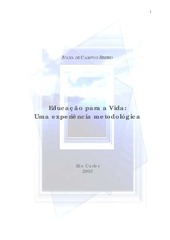| dc.contributor.author | Ribeiro, Ivana de Campos | |
| dc.date.accessioned | 2016-06-02T19:30:07Z | |
| dc.date.available | 2005-05-13 | |
| dc.date.available | 2016-06-02T19:30:07Z | |
| dc.date.issued | 2003-06-27 | |
| dc.identifier.citation | RIBEIRO, Ivana de Campos. Educação para a vida: uma experiência metodológica.. 2003. 298 f. Tese (Doutorado em Ciências Biológicas) - Universidade Federal de São Carlos, São Carlos, 2003. | por |
| dc.identifier.uri | https://repositorio.ufscar.br/handle/ufscar/1839 | |
| dc.description.abstract | The deep crises, which we live in the social and natural environment,
have their origin in the way we understand and act on them. The values
that we give to theses environments not only reflect our way of thinking
and acting, but also the way we try to solve the problems. The
(Environmental) Education, in this sense, can contribute immensily. This work
refers to the intervention made in a Primary school of Rio Claro city, state of
São Paulo, with the teachers stuff as a way of preparing them to a
methodological proposal, the Environmental Education of Body & Soul
,and its five stages model, whose main characteristic is to join cognitive
experiences with emotional ones, through the utilization of animismmist
activities, having the water as generator theme of transversatility. Its main
goal is the inquiry of the applicability potential of the educators proposal,
who developed their works together with the students. We expected to
stimulate changing, in both teachers and students, in their manner of
understanding and acting on the different environments that they live.
After two years of intervention, we could see the applicability of this
proposal on the part of the teacher whose major indicators were the results
observed with the students. Among them: the highest rates of conceptual
information retention were linked with the subjects that took more
advantages of the animismmist activities, the favoritism of more
pleasurable scholar environment, bigger interest and involvement in
environmental matters; besides the perception of the connections among
the subjects and their contents, favoring the net knowledge, collaborating
to the knowledge unification. Other indicators of the positive effects are:
the comprehension of the human being like part of the nature, where the
human actions against the nature harm the own human; and, the
valorization of our natural resources, demonstrated as phrases of affective
contents. | eng |
| dc.description.sponsorship | Universidade Federal de Minas Gerais | |
| dc.format | application/pdf | por |
| dc.language | por | por |
| dc.publisher | Universidade Federal de São Carlos | por |
| dc.rights | Acesso Aberto | por |
| dc.subject | Educação ambiental | por |
| dc.subject | Professores formação | por |
| dc.subject | Afetividade | por |
| dc.subject | Percepção | por |
| dc.subject | Transdisciplinaridade | por |
| dc.title | Educação para a vida: uma experiência metodológica. | por |
| dc.type | Tese | por |
| dc.contributor.advisor1 | Oliveira, Haydée Torres de | |
| dc.contributor.advisor1Lattes | http://lattes.cnpq.br/5458113597909705 | por |
| dc.description.resumo | As profundas crises que vivemos nos ambientes sociais e naturais,
têm suas origens na forma como compreendemos e agimos sobre eles. Os
valores que damos a estes ambientes também refletem não só nossa
forma de pensar e de agir sobre esses ambientes, mas a forma como
tentamos resolver esses problemas. A educação (Ambiental) nesse sentido,
pode ter muito a contribuir. Este trabalho se refere à intervenção realizada
em uma escola de Ensino Fundamental do município de Rio Claro/SP, junto
à equipe de professores como forma de prepará-los para a utilização de
uma proposta metodológica, a Educação Ambiental de Corpo&Alma e
seu Modelo das 5 Fases , cuja característica principal está em aliar
experiências cognitivas às afetivas, por meio da utilização de atividades
anímicas , tendo como tema gerador de transversalidade a questão da
água. Seu principal objetivo - a averiguação do potencial de
aplicabilidade da proposta por educadores os quais, ao desenvolverem
seus trabalhos junto aos alunos, esperávamos estimular mudanças, tanto
nos educadores como nos alunos, em sua forma de compreender e de
agir sobre os diferentes ambiente em que vivem: seu próprio corpo, a
sociedade e a natureza. Após dois anos de intervenção, pudemos verificar
a aplicabilidade da proposta por parte dos professores, cujos maiores
indicadores estavam nos resultados observados junto aos alunos. Entre
eles: o maior índice de retenção de informações conceituais estarem
relacionadas às disciplinas que mais se valeram das atividades anímicas; o
favorecimento do ambiente escolar mais prazeroso o maior interesse e
envolvimento em questões ambientais, além da percepção das ligações
entre as disciplinas e seus conteúdos, favorecendo o conhecimento em
rede. Encontravam-se ainda entre os indicadores, a compreensão do ser
humano como parte da natureza, onde as ações humanas contra ela
acabam prejudicando o próprio ser humano e, a valorização dos nossos
bens naturais, demonstradas em frases de conteúdos afetivos. | por |
| dc.publisher.country | BR | por |
| dc.publisher.initials | UFSCar | por |
| dc.publisher.program | Programa de Pós-Graduação em Ecologia e Recursos Naturais - PPGERN | por |
| dc.subject.cnpq | CIENCIAS BIOLOGICAS::ECOLOGIA | por |
